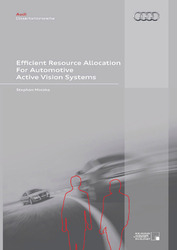| Departments | |
|---|---|
| Book Series (96) |
1378
|
| Nachhaltigkeit |
3
|
| Gesundheitswesen |
1
|
| Humanities |
2362
|
| Natural Sciences |
5406
|
| Engineering |
1790
|
| Engineering | 291 |
| Mechanical and process engineering | 861 |
| Electrical engineering | 686 |
| Mining and metallurgy | 30 |
| Architecture and civil engineering | 75 |
| Common |
97
|
|
Leitlinien Unfallchirurgie
5. Auflage bestellen |
|
Advanced Search
Efficient Resource Allocation for Automotive Active Vision Systems (Volume 24) (English shop)
Stephan Matzka (Author)Preview
Table of Contents, Datei (46 KB)
Extract, Datei (130 KB)
The main goal when operating a vehicle is to safely participate in road-traffic while minimising the adverse effects on our environment. This goal is pursued by road safety measures ranging from safety-oriented road design to driver assistance systems. The latter require exteroceptive sensors to acquire information about the vehicle‘s current environment. In this thesis an efficient resource allocation algorithm for automotive vision systems is proposed. The novel system architecture is shown to efficiently allocate both high-resolution sensor resources and computational expensive processes based upon low-resolution sensor data. The Pareto efficient decision making process used for resource allocation is formalised, implemented, and evaluated using road traffic test sequences acquired by a multi-modal sensor system on a test vehicle provided by AUDI AG.
| ISBN-13 (Printausgabe) | 3869552506 |
| ISBN-13 (Hard Copy) | 9783869552507 |
| ISBN-13 (eBook) | 9783736932500 |
| Language | English |
| Page Number | 312 |
| Edition | 1 Aufl. |
| Book Series | Audi Dissertationsreihe |
| Volume | 24 |
| Publication Place | Göttingen |
| Place of Dissertation | University Edinburgh Heriot-Watt |
| Publication Date | 2010-02-09 |
| General Categorization | Dissertation |
| Departments |
Electrical engineering
|








